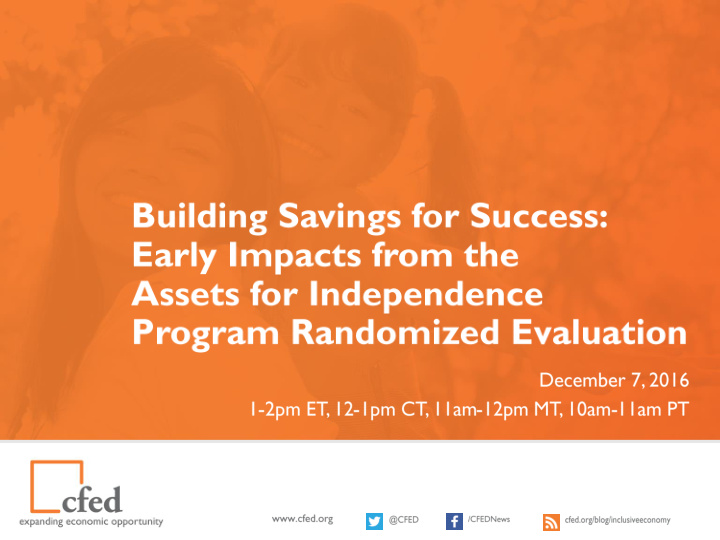



Who We Are Our mission at CFED is to make it possible for millions of people to achieve financial security and contribute to an opportunity economy.
How do we do it We push to expand innovative practical solutions that empower low- and moderate-income people to build wealth. We drive policy change at all levels of government. We support the efforts of community leaders across the country to advance economic opportunity for all.
• • •
Participants can only make deposits, not AFI IDA Participant withdrawals, from these Participant IDA Accounts are special Participant accounts except under withdrawal-restricted Deposits Account specific circumstances savings accounts with the grantee’s signature @CFED facebook.com/CFEDNews cfed.org/blog/inclusiveeconomy
Post-Secondary Business Capitalization First Home Education or Training ** Or a transfer to a dependent or spouse for one of these purposes. @CFED facebook.com/CFEDNews cfed.org/blog/inclusiveeconomy
Urban Institute To open minds, shape decisions, and offer solutions through economic and social policy research. 1
Building Savings for Success: Early Impacts from the Assets for Independence Program Randomized Evaluation Gregory Mills, Signe-Mary McKernan, Caroline Ratcliffe, Sara Edelstein, Mike Pergamit, Breno Braga, Heather Hahn, and Sam Elkin
14 Funding US Department of Health and Human Services, Administration for Children and Families Assets for Independence (AFI) Program on Savings, Savings Patterns and Assets Purchase for Low Income Individuals and Families Contract #: HHSP23320095654WC
15 Participating sites Albuquerque Los Angeles Prosperity Works & Central New RISE Financial Pathways Mexico Community College Match rate: 4-to-1 Match rate: 2.5-to-1 Max savings period: varied Max savings period: 24 months Coaching model Case management model Participants reach out for support Staff reach out regularly; more and lead the decision-making “hand - holding” College setting with complementary Stand alone organization services
16 Study participant characteristics at enrollment Under age 40, female, nonwhite, unmarried, and had some college education. About half with annual household income below $15,000, and nearly all employed. Generally reflect FY 2014 AFI participants nationwide except • More Hispanic (45% study vs 23% nationwide) • Less white (15% study vs 32% nationwide) • Fewer HS/GED only (18% study vs 37% nationwide)
17 Project services 78% of participants opened an IDA 85% participated in financial education 3% made unmatched withdrawals Savings in IDA (Albuquerque only) • Mean $691, median $762
18 AFI increases liquid assets Share of participants Median liquid asset amount with liquid assets $657*** 7pp*** $881 89% 82% Non-participant (control) AFI participant (treatment) $224 Combined
19 AFI reduces material hardship Average number of hardships Average number of utility hardships -1.0** 2.8 Non-participant (control) AFI participant 1.8 (treatment) -0.4*** 1.1 0.7
20 AFI reduces non-bank check cashing use Share that use non-bank check cashing -4pp* 9% Non-participant (control) AFI participant 6% (treatment) Combined
21 AFI improves perceived financial security Confidence about Share who report Share who report meeting one’s financial situation financial situation expenses (1-10 scale) improved worsened +0.5** Non-participant (control) 5.4 +7pp* 4.9 AFI participant (treatment) 44% 37% -10pp*** 25% 15%
22 The AFI Program after one year Increases savings (primary goal) Keeps participants connected with benefits Reduces material hardship Reduces financial worry
23 Emerging insights and potential implications AFI program rules allowing low-income households to save without reducing other federal program benefits may be instrumental in averting material hardship Integrate saving and financial education into existing programs AFI program is one of few federal efforts that actively encourages saving among low-income families Federal asset-building subsidies benefit high-income
Opportunity and Ownership Initiative Research FIND US: SUBSCRIBE TO OUR MONTHLY NEWSLETTER ON OUR http://urbn.is/oo WEBSITE: http://urbn.is/oando Building Savings for Success: Early Impacts from the Assets for Independence Randomized Program Evaluation Asset limits Financial coaching evaluation Why family financial security matters for cities
Questions, ideas, comments? Share them in the Questions box! @CFED /CFEDNews cfed.org/blog/inclusiveeconomy
• • @CFED /CFEDNews cfed.org/blog/inclusiveeconomy
Our Vision At CFED, we envision an opportunity economy where we are all empowered to build more prosperous futures for ourselves, our families and our country.
Recommend
More recommend